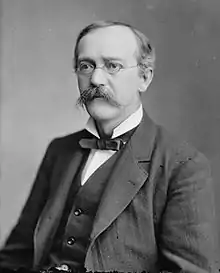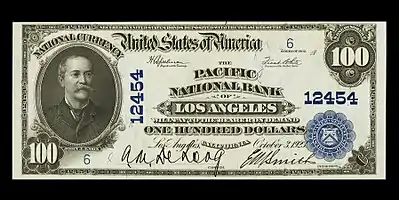John Jay Knox Jr.
John Jay Knox Jr. (March 19, 1828 – February 9, 1892)[1] was an American financier and government official. He is best remembered as a primary author of the Coinage Act of 1873, which discontinued the use of the silver dollar.
John Jay Knox Jr. | |
|---|---|
 Photograph of Knox, by Mathew Brady | |
| 4th Comptroller of the Currency | |
| In office April 25, 1872 - April 30, 1884 | |
| President | Ulysses S. Grant Rutherford B. Hayes Chester A. Arthur |
| Preceded by | Hiland R. Hulburd |
| Succeeded by | Henry W. Cannon |
| Personal details | |
| Born | March 19, 1828 Knoxboro, New York, U.S. |
| Died | February 9, 1892 (aged 63) New York City, New York, U.S. |
| Spouse(s) | Caroline Elizabeth Todd |
| Parents | John Jay Knox Sarah Ann Curtis Knox |
| Alma mater | Hamilton College |
Knox was Comptroller of the Currency from 1872 to 1884. An advocate of uniform currency for the national banks of the country, his portrait was featured on the obverse of the $100 United States national bank notes of the Series of 1902.
Early life
John Jay Knox Jr. was born March 19, 1828, in Knoxboro, New York, today a part of the city of Augusta.[2] He was a son of Sarah Ann (née Curtis) Knox (1794–1875) and John J. Knox Sr. (1791–1876),[3] a prominent merchant and bank president and was himself the namesake of Knoxboro.[4][5]
The younger Knox was well educated and attended Hamilton College in Clinton, New York, from which he graduated in 1849.[4]
Career
Upon graduation he went to work for his father in his bank, working there as a teller for two years before moving to a bank in Syracuse, New York, where he worked for four more years.[4] Knox gained experience and authority in a series of further jobs in the banking industry which followed, including stops in Binghamton, New York, Norfolk, Virginia.[4]
Private banker
In 1857, shortly before Minnesota was admitted to the United States, Knox and his brother, Henry M. Knox, launched their own banking house in the city of St. Paul.[6] John Jay Knox would remain with that firm for six years.[4]
Knox was an advocate of the system of national banks proposed by U.S. Secretary of the Treasury Salmon P. Chase and contributed ideas to the national bank debate, advocating safe and convertible notes of a uniform type for all national banks, backed by the guarantee of government bonds.[6] He authored two influential articles on the matter, published in Hunt's Merchants' Magazine in 1861 and 1862, which gained the notice of Secretary Chase.[6] Chase would bring Knox into the service of the Treasury Department in 1863.[4]
Government career

Working in the Treasury Department throughout the closing years of the American Civil War, in 1866 Knox was put in charge of the Mint and Coinage Correspondence for that department.[6] He authored a report on the San Francisco Mint in 1866 and later in that same year discovered a $1.1 million misappropriation of funds in a similar report on the activities of the New Orleans Mint — the largest such misappropriation in US government history up to that time.[6]
Knox was made Deputy Comptroller of the Currency in 1867. In that capacity in April 1870, Knox prepared a 100-page report codifying the mint and coinage laws of the United States.[4] This was followed in June 1870 with another report of similar length, collecting the views of mint employees and financial experts and providing for legislation to eliminate the silver dollar from circulation.[4] Knox's proposal was passed into law after a few amendments as the Coinage Act of 1873 — an event which triggered a rapid fall in the price of silver and which ushered in an era of bitter currency debate which dominated the political landscape for the better part of three decades.[4]
President Ulysses S. Grant promoted Knox to Comptroller of the Currency in 1872.[7] He was reappointed to a second 5-year term by President Rutherford B. Hayes in 1877, and to a third term by President Chester A. Arthur in 1882.[7]
On May 1, 1884, Knox resigned his post in order to become president of the National Bank of the Republic in New York City.[8] At the time of his resignation he had served 17 years in the Comptroller's office as part of almost 22 years in the Treasury Department, making him the longest serving officer in that department.[7]
Personal life
Knox was married to Caroline Elizabeth Todd (1847–1922), a daughter of Elizabeth Irving (née Gilliss) Todd and William Balch Todd, a director of the Bank of the Metropolis. Together, they were the parents of:[5]
- John Jay Knox (1874–1875), who died in infancy.
- John Jay Knox III (1877–1913), who died in Colorado Springs.[9]
- Irving Gilliss Knox (1879–1921),[10] a Yale University graduate who became a member of L.F. Rothschild & Co. in New York.[11]
- Herman Warren Knox (1882–1931), the former secretary of the Texas and Pacific Oil Company.[12]
Knox died at his home in New York City on February 9, 1892.[13][1] He was 63 years old at the time of his death and was buried at Oak Hill Cemetery in Washington.[14][15] His widow died in 1922 while she was President of the Women's Board of the Babies Hospital.[16]
Works
| Wikisource has original works written by or about: John J. Knox |
- The Surplus and the Public Debt: Address of the Hon. John Jay Knox...at the Annual Convention of the American Bankers' Association at Pittsburgh, Pennsylvania, October 12, 1887. New York: Bankers' Publishing Association, 1887.
- Interview of John Jay Knox...Before the Committee on Coinage, Weights, and Measures of the House of Representatives upon the Coinage Act of 1873 and the Silver Question, Saturday, February 21, 1891. Washington, DC: Government Printing Office, 1891.
- United States Notes: A History of the Various Issues of Paper Money by the Government of the United States. Revised Third Edition. New York: Charles Scribner's Sons, 1892.
- History of Banking in the United States. By late John Jay Knox, assisted by Corps of Financial Writers, Revised and Brought Up to Date by Bradford Rhodes and Elmer H. Youngman, New York: Bradford Rhodes & Company, 1900.
References
- "Mr. John Jay Knox,". The New York Times. 10 February 1892. Retrieved 26 March 2020.
- Fairbanks, Mary Mason (1898). Emma Willard and Her Pupils: Or, Fifty Years of Troy Female Seminary, 1822-1872. Mrs. R. Sage. p. 342. Retrieved 26 March 2020.
- Annual Report. New-York Historical Society. 1951. p. 68. Retrieved 26 March 2020.
- "John Jay Knox," National Cyclopaedia of American Biography: Volume 3. New York: James T. White & Co., 1893; pg. 15.
- The Sixtieth Anniversary of the Marriage of John J. and Sarah Ann Knox, October 7th, 1873. E.O. Jenkins. 1873. p. 107. Retrieved 26 March 2020.
- George G. Evans (ed.), Illustrated History of the United States Mint, with a Complete Description of American Coinage... Philadelphia: George G. Evans, 1888; pg. 95.
- "John Jay Knox," National Cyclopaedia of American Biography: Vol. 3, pg. 16.
- "John Jay Knox on the Currency". The New York Times. 11 February 1890. Retrieved 26 March 2020.
- "Died: KNOX". The New York Times. 7 January 1913. Retrieved 26 March 2020.
- "DIED : KNOX". The New York Times. 25 September 1921. Retrieved 26 March 2020.
- University, Yale (1921). Obituary Record of Graduates of Yale College: Deceased During the Academic Year ... Tuttle, Morehouse & Taylor Company. p. 473. Retrieved 26 March 2020.
- "HERMAN W. KNOX. Retired Oil Company Official Dies Suddenly of Heart Attack". The New York Times. 12 June 1931. Retrieved 26 March 2020.
- "DIED". The New York Times. February 11, 1892. Retrieved 26 March 2020.
- "John Jay Knox's Funeral.; Services in the Church of the Epiphany in Washington". The New York Times. 14 February 1892. Retrieved 26 March 2020.
- "John Jay Knox's Funeral.; Attended by Many Prominent Busi- Ness and Professional Men". The New York Times. 13 February 1892. Retrieved 26 March 2020.
- "DIED". The New York Times. 17 August 1922. Retrieved 26 March 2020.
External links
| Political offices | ||
|---|---|---|
| Preceded by Hiland R. Hulburd |
Comptroller of the Currency 1872–1884 |
Succeeded by Henry W. Cannon |